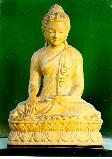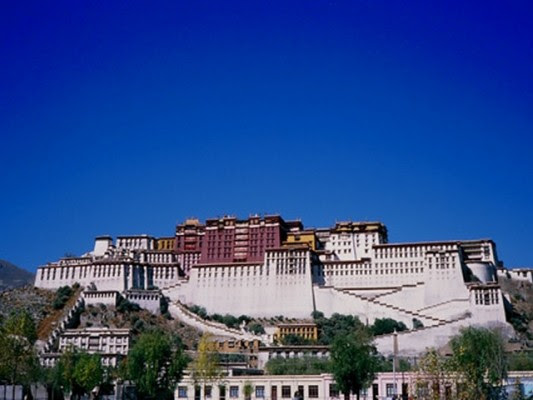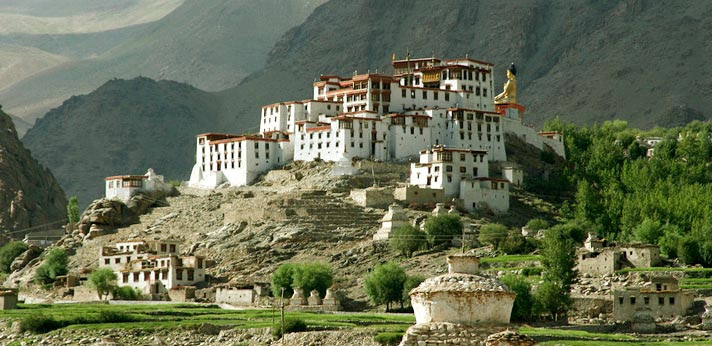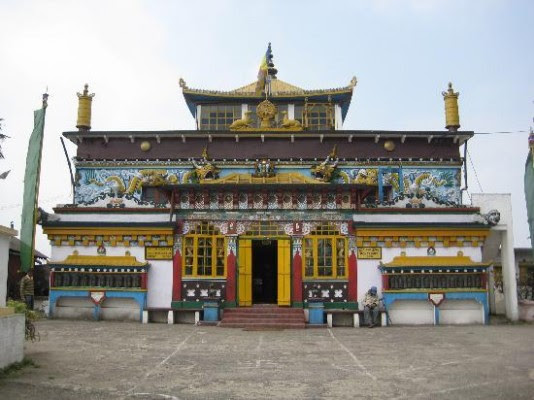http://www.buddhanet.net/pali_chant.htm
Pali Chanting in the Theravada Buddhist Tradition
* Basic Pronunciation
Vandanâ
Namô Tassa Bhagavatô Arahatô Sammâ-Sambuddhassa (3x)
Homage to the Triple Gems
Homage to Him, the Blessed One, the Exalted One, the Fully Enlightened One.
Ti-Sarana
Buddham Saranam Gacchâmi.
Dhammam Saranam Gacchâmi.
Sangham Saranam Gacchâmi.
Dutiyampi Buddham Saranam Gacchâmi.
Dutiyampi Dhammam Saranam Gacchâmi.
Dutiyampi Sangham Saranam Gacchâmi.
Tatiyampi Buddham Saranarn Gacchâmi.
Tatiyampi Dhammam Saranam Gacchâmi.
Tatiyampi Sangham Saranam Gacchâmi.
Translation: The Three Refuges
I go to the Buddha as my refuge.
I go to the Dhamma - The Teachings, as my Refuge.
I go to the Sangha - The Community, as my Refuge.
For the second time I go to the Buddha as my Refuge.
For the second time I go to the Dhamma - The Teachings, as my Refuge.
For the second time I go to the Sangha - The Community, as my Refuge.
For the third time I go to the Buddha as my Refuge.
For the third time I go to the Dhamma - The Teachings, as my Refuge.
For the third time I go to the Sangha - The Community, as my Refuge.
Panca-sila
Pânâtipâtâ Veramani Sikkhâpadam Samâdiyâmi.
Adinnâdânâ Veramani Sikkhâpadam Samâdiyâmi.
Kâmesu Micchâcârâ Veramani Sikkhâpadam Samâdiyâmi.
Musâvâdâ Veramani Sikkhâpadam Samâdiyâmi.
Surâ Mêraya Majja Pamâdatthânâ Verami Sikkhâpadam Samâdiyâmi
Imâni Panca Sikkhâpadâni Samâdiyâmi (3x)
Translation: The Five Precepts
I undertake to observe the precept to abstain from destroying living beings.
I undertake to observe the precept to abstain from taking things not given.
I undertake to observe the precept to abstain from sexual misconduct.
I undertake to observe the precept to abstain from false speech.
I undertake to observe the precept to abstain from liquor causing intoxication and heedlessness.
I undertake to observe the Five Precepts to the best of my ability.(3x)
Buddha Vandana
Iti pi so Bhagavâ-Araham Sammâ-sambuddho.
Vijjâ-carana sampanno Sugato Lokavidû Anuttarro
Purisa-damma-sârathi Satthâ deva-manussânam
Buddho Bhagavâti
Translation - Homage to the Buddha
Thus indeed, is that Blessed One: He is the Holy One, fully
enlightened, endowed with clear vision and virtuous conduct, sublime,
the Knower of the worlds, the incomparable leader of men to be tamed,
the teacher of gods and men, enlightened and blessed.
Dhamma Vandana
Svâkkhato Bhagavatâ Dhammo Sanditthiko Akâliko Ehi-passiko Opanâyiko Paccattam
veditabbo viññuhiti.
Translation - Homage to the Teachings
The Dhamma of the Blessed One is perfectly expounded; to be seen here and how; not delayed in
time; inviting one to come and see; onward leading (to Nibbana); to be known by the wise, each for himself.
Sangha Vandana
Supati-panno Bhagavato sâvaka sangho, Ujupati-panno Bhagavato sâvaka sangho.
Ñâya-patipanno Bhagavato sâvaka sangho. Sâmici-patipanno Bhagavato sâvaka sangho
Yadidam cattâri purisa yugâni attha-purisa-puggalâ Esa Bhagavato sâvaka sangho.
Âhu-neyyo, pâhu-neyyo, Dakkhi-neyyo,añjalikaraniyo, anuttaram puññakkhetam lokassâti
Translation - Homage to the Disciples of the Buddha
The Sangha of the Blessed One’s disciples has entered on the good way;
the Sangha of the Blessed One’s disciples has entered on the straight
way; the Sangha of the Blessed One’s disciples has entered on the proper
way, that is to say; the Four Pairs of Men, the Eight Types of Persons;
the Sangha of the Blessed One’s disciples is fit for gifts, fit for
hospitality, fit for offerings, and fit for reverential salutation, as
the incomparable field of merit for the world.
Maha-Mangala Sutta
Êvam mê suttam êkam samayam bhagavâ Sâvatthiyam viharati Jêtavanê Anâthapindikassa ârâmê,
atha kho aññatarâ dêvatâ abhikkantaya rattiyâ abhikanta vannâ
kêvalakappam Jêtavanam bhâsetvâ, yêna bhagavâ tênupasamkami. Upasam
kamitvâ bhagavantam abhivâdetvâ êkamantam atthâsi. Êkamantam thitâ kho
sâ dêvatâ bhagavantam gâthâya ajjhabhâsi.
Bahû dêvâ manussâ ca mangalâni acintayum
Âkankhamânâ sotthânam brûhi mangala muttamam.
Asêvanâ ca bâlânam panditânam ca sêvanâ
Pûjâ ca pûjaniyânam êtam mangala muttamam
Patirûpa dêsa vâso ca pubbê ca kata puññatâ
Atta sammâ panidhi ca êtam mangala muttamam
Bâhu saccam ca sippan ca vinayo ca susikkhito
Subhasitâ ca yâ vâcâ êtam mangala muttamam
Mâtâ pitu upâtthanam puttadârassa sangaho
Anâkulâ ca kammantâ êtam mangala muttamam
Dânam ca dhamma cariyâ ca ñâtakanam ca sangaho
Anavajjâni kammâni êtam mangala muttamam
Ârati virati pâpâ majjapânâ ca saññamo
Appamâdo ca dhammêsu êtam mangala muttamam
Gâravo ca nivâto ca santutthi ca kataññutâ
Kâlêna dhamma savanam êtam mangala muttamam
Khanti ca sôvacassatâ samanânam ca dassanam
Kâlêna dhamma sâkacchâ êtam mangala muttamam
Tapô ca brahman cariyam ca ariya saccâ na dassanam
Nibbâna sacchi kiriyâ ca êtam mangala muttamam
Phutthassa lôka dhammêhi cittam yassa na kampati
Asokam virajam khêmam êtam mangala muttamam
êtâdisâni katvâna sabbattha maparâjitâ
Sabbhattha sotthim gacchanti tam têsam mangala muttamanti.
Translation: Discourse on Blessings
Thus have I heard: On one occasion the Exalted One was dwelling at the
monastery of Anathapindika, in Jeta’s Grove, near Savatthi. Now when the
night was far spent, a certain deity, whose surpassing splendour
illuminated the entire Jeta Grove, came to the presence of the Exalted
One, and, drawing near, respectfully saluted Him and stood at one side.
Standing thus, he addressed the Exalted One in verse:
Many deities and men, yearning after good, have pondered on Blessings. Pray, tell me the Highest Blessing!
Not to associate with fools, to associate with the wise, and to honour
those who are worthy of honour - this is the Highest Blessing.
To
reside in a suitable locality, to have done meritorious actions in the
past, and to set oneself in the right course - this is the Highest
Blessing.
Vast-learning, perfect handicraft, a highly trained discipline, and pleasant speech
- this is the Highest Blessing.
The support of father and mother, the cherishing of wife and children, and peaceful occupations - this is the Highest Blessing.
Liberality, righteous conduct, the helping of relatives, and blameless actions
- this is the Highest Blessing.
To cease and abstain from evil, forbearance with respect to
intoxicants, and steadfastness in virtue - this is the Highest Blessing.
Reverence, humility, contentment, gratitude and the opportune hearing of the Dhamma
- this is the Highest Blessing.
Patience, obedience, sight of the Samanas (Sanctified Ones), and
religious discussions at due seasons - this is the Highest Blessing.
Self Control, Holy Life, perception of the Noble Truths, and the realisation of Nibbana
- this is the Highest Blessing.
He whose mind does not flutter by contact with worldly contingencies,
Sorrowless, Stainless, and Secure - this is the Highest Blessing.
To them, fulfilling matters such as these, every-where invincible, in
every way moving happily - these are the Highest Blessings.
Karaniya Sutta
Karanîya - mattha kusalêna - yantam santam padam abhisamecca,
Sakkô ujû ca sûjû ca - suvaco cassa mudu anati mâni.
Santussakô ca subharô ca - appa kicco ca salla-huka vutti,
Santindriyô ca nipakô ca - appagabbhô kulêsu ananugiddhô.
Na ca khuddam samâcarê kinci - yêna viññu parê upavadeyyum
Sukhinô vâ kheminô hontu - Sabbê sattâ bhavantu sukhitattâ.
Yêkêci pâna bhûtatthi - tasâ vâ thâvarâ vâ anava, sêsâ,
Dîghâ vâ yê mahantâ vâ — majjhimâ rassakâ - nuka thûlâ.
Ditthâ vâ yêva additthâ - yêca dûrê vasanti avidûrê,
Bhûta vâ sambhavêsi vâ - sabbê sattâ bhavantu sukhitattâ.
Na parô param nikubbêtha - nâti maññêtha katthaci nam kanci,
Byârôsanâ patigha saññâ - nâñña - maññassa dukkha miccheyya.
Mâtâ yathâ niyam puttam - âyusâ êka putta manu rakkhe,
Êvampi sabba bhûtêsu - mânasam bhâvayê aparimânam.
Mettam ca sabba lôkasmin - mânasam bhâvayê aparimânam,
Uddham adhô ca tiriyam ca - asambâdham avêram asapattam.
Tittham caram nisinnô vâ - sayâno vâ yâva tassa vigata middho,
Êtam satim adhittheyya — brahma mêtam vihâram idhamâhu.
Ditthin ca anupa gamma - sîlavâ dassanêna sampanno,
Kâmêsu vineyya gêdham - nahi jâtu gabbhaseyyam punarêtiti.
Translation: Discourse on Loving Kindness
He who is skilled in his good and who wishes to attain that state of
Calm should act (thus:) He should be able, upright, perfectly upright,
obedient, gentle, and humble.
Contented, easily supportable, with
few duties, of light livelihood, controlled in senses, discreet, not
imprudent, not be greedily attached to families.
He should not commit any slight wrong such that other wise men might censure him. May all
beings be happy and secure. May their minds be wholesome.
Whatever living beings there be: feeble or strong, long, stout, or
medium, short, small, or large, seen or unseen, those dwelling far or
near, those who are born and those who are to be born –may all beings,
without exception, be happy-minded!
Let not one deceive another
nor despise any person whatever in any place. In anger or ill will, let
him not wish any harm to another.
Just as a mother would protect
her only child even at the risk of her own life, even so let him
cultivate a boundless heart towards all beings.
Let his thoughts
of boundless love pervade the whole world: above, below and
across–without any obstruction, without any hatred, without any enmity,
Whether he stands, walks, sits or lies down, as long as he is awake, he
should develop mindfulness. This, they say, is the Highest Conduct.
Not falling into error, virtuous and endowed with insight, he gives up
attachment to sense-desires. He will surely not be born in any womb
again.
Ratana Sutta
Yânîdha bhûtâni samâgatâni - bhummâni vâ yâ niva antalikkhê
Sabbêva bhûtâ sumanâ bhavantû - athôpi sakkacca sunantu bhâsitam.
Tasmâhi bhûtâni sâmêtha sabbê - mettam karôtha mânusiya pajâya,
Divâ ca rattô ca haranti yê balim - tasmâhi nê rakkhatha appamattâ.
Yam kinci vittam idha vâ huram vâ - saggêsu vâ yam ratanam panitam,
Nano samam atthi tathâgatena - idampi buddhê ratanam panîtam,
Êtêna saccêna suvatthi hôtu.
Khayam virâgam amatam panîtam - yadajjhagâ sakkyamunî samâhito,
Na têna dhammena samatthi kinci - idampi dhammê ratanam panîtam
Êtêna saccêna suvatthi hôtu.
Yambuddha settho parivannayî sucim - samâdhi mânam tarikañña mâhu
Samâdhinâ têna samô na vijjati - idampi dhammê ratanam panîtam
Êtêna saccêna suvatthi hôtu.
Ye puggalâ attha satam pasatthâ - cattâri êtâni yugâni honti,
Te dakkhineyyâ sugatassa sâvakâ - êtêsu dinnâni mahapphalâni,
Idampi sanghê ratanam panîtam - êtêna saccêna suvatthi hôtu.
Ye suppa yuttâ manasâ dalhêna - nikkamino gôtama sâsanamhi
Te patti pattâ amatam vigayha - laddhâ mudhâ nibbutim bhunjamânâ
Idampi sanghê ratanam panîtam - êtêna saccêna suvatthi hôtu.
Yathinda khîlo pathavim sito siyâ - catubbhi vâtêbhi asampa kampiyo,
Tathûpamam sappurisam vadâmi — yô ariya saccâni avecca passati,
Idampi sanghê ratanam panîtam - êtêna saccêna suvatthi hôtu.
Yê ariya saccâni vibhâvayanti - gambhira paññnêna sudêsitâni,
Kincâpi tê honti bhusappamattâ - na te bhavam attamam âdiyanti,
Idampi sanghê ratanam panîtam - êtêna saccêna suvatthi hôtu.
Sahâvassa dassana sampadâya - tayassu dhammâ jahitâ bhavanti,
Sakkâya ditthi vicikicchitam ca — silabbatam vâpi yadatthi kinci,
Catûhapâye hi ca vippamutto - Chacâbhi thânâni abhabbo kâtum,
Idampi sanghê ratanam panîtam - êtêna saccêna suvatthi hôtu.
Kincâpi sô kammam karôti pâpakam - kâyêna vâcâ udacêtasâ vâ,
Abhabbo sô tassa paticchâdâya - abhabbatâ ditta padassa vuttâ,
Idampi sanghê ratanam panîtam - êtêna saccêna suvatthi hôtu.
Vanappagumbê yathâ phussitaggê - gimhâna mâsê pathamasmin gimhe,
Tathûpamam dhamma varam adêsayi — nibbânagâmin paramam hitâya,
Idampi buddhê ratanam panîtam - êtêna saccêna suvatthi hôtu.
Varô varaññû varadô varâharo - anuttarô dhamma varam adêsayi,
Idampi buddhê ratanam panîtam - êtêna saccêna suvatthi hôtu.
Khinam purânam navam netthi sambhavam - viratta cittâ âyatike bhavasmim,
Te khina bijâ avirulhicchandâ - nibbanti dhirâ yathâ yam padipo
Idampi sanghê ratanam panîtam - êtêna saccêna suvatthi hôtu.
Yânîdha bhûtâni samâgatani — bhummani vâ yâniva antalikkhe,
Tathâgatam dêva manussa pûjitam- Buddham namasâma suvatthi hotu.
Yânîdha bhûtâni samâgatani — bhummani vâ yâniva antalikkhe,
Tathâgatam dêva manussa pûjitam - Dhammam namassâma suvatthi hotu.
Yânîdha bhûtâni samâgatani — bhummani vâ yâniva antalikkhe,
Tathâgatam dêva manussa pûjitam - Sangham namassâma suvatthi hotu.
Translation - The Jewel Discourse
This Discourse was delivered by the Buddha in the city of Vesali whose
citizens appealed to the Buddha for help, being afflicted by famine,
pestilenee and disturbances from evil spirits. As a mark of protection
for the people of Vesali, the Buddha delivered this discourse after
which the evil spirits were exorcised and the pestilence subsided.
Whatever beings are here assembled, whether terrestrial or celestial, may they all be happy!
Moreover may they attentively listen to my words!
Accordingly give good heed, all ye beings! Show your love to the human
beings who, day and night, bring offerings to you. Wherefore guard them
zealously.
Whatever treasure there be either here or in the world
beyond, or whatever precious jewel in the precious jewel. By this truth
may there be happiness!
The tranquil Sage of the Sakyas realised that Cessation, Passion-free, Immortality Supreme.
There is nought comparable with the Dhamma. Verily, in the Dhamma is this precious jewel.
By this truth may there be happiness!
That Sanctity praised by the Buddha Supreme is described as
“concentration without interruption. There is nought like that
Concentration. Verily, in the Dhamma is this precious jewel. By this
truth may there be happiness!
Those Eight Individuals, praised by
the virtuous, constitute four pairs. They, the worthy of offerings, the
disciples of the Welcome One, - to these gifts given yield abundant
fruit.
Verily, in the Sangha is this precious jewel.
By this truth may there be happiness!
With steadfast mind, applying themselves thoroughly in the Dispensation
of Gotama, exempt (from passion), they have attained to “that which
should be attained”, and, plunging into the Deathless, they enjoy Peace
obtained without price.
Verily, in the Sangha is this precious jewel.
By this truth may there be happiness!
Just as a firm post, sunk in the earth, cannot be shaken by the four
winds; even so do I declare him to be a righteous person who thoroughly
perceives the Noble Truths.
Verily, in the Sangha is the precious jewel.
By this truth may there be happiness!
Those who comprehend clearly the Noble Truths, well taught by Him of
wisdom deep, do not, however exceeding heedless they may be, undergo an
eighth birth.
Verily, in the Sangha is this precious jewel.
By this truth may there be happiness!
For him with the acquisition of Insight, three conditions come to
nought - namely, self-illusion, doubt, and indulgence in (wrongful)
rites and ceremonies, should there be any. From the four states of
misery, he is absolutely freed, and is incapable of committing the six
heinous crimes.
Verily, in the Sangha is this precious jewel.
By this truth may there be happiness!
Whatever evil deed he does, whether by deed, word or thought, he is
incapable of hiding it; for it hath been said that such an act is
impossible for one who has seen the Path.
Verily, in the Sangha is this precious jewel.
By this truth may there be happiness!
Like unto the woodland groves with blossomed tree tops in the first
heat of the summer season, hath the sublime doctrine, that leads to
Nibbana, been taught for the Highest Good.
Verily, in the Buddha is this precious jewel.
By this truth may there be happiness.
The unrivalled Excellent One, the Knower, the Giver, and the Bringer of the Excellent has expounded the excellent Doctrine.
Verily, in the Buddha is this precious jewel.
By this truth may there be happiness!
Their past is extinct, a fresh becoming there is not, their minds are
not attached to a future birth, their desires grow not - those wise ones
go out even as this lamp.
Verily, in the Sangha is this precious jewel.
By this truth may there be happiness!
We beings here assembled, whether terrestrial or celestial, salute the
Accomplished Buddha, honoured by gods and men. May there be happiness!
We beings here assembled, whether terrestrial or celestial, salute the
Accomplished Dhamma, honoured by gods and men. May there be happiness!
We beings here assembled, whether terrestrial or celestial, salute the
Accomplished Sangha, honoured by gods and men. May there be happiness!
* Basic Pronunciation
a as a in what â as a in father
i as i in mint î as ee in see
u as u in put û as oo in pool
e as a in cage o as o in no
n as ng in sing ñ as gn in signore
Pausing
Prolong for vowels with ^ or ( - ) such as â, î , û, e and o.
Pause for double letter such as dd in Buddha : Bu-ddha,
mm in Dhammam : Dha-mmam, ss in Ehi-passiko : E-hi-pa-ssiko






















 Online and Offline Tipiṭaka Law Research & Practice University
in
112 CLASSICAL LANGUAGES
Online and Offline Tipiṭaka Law Research & Practice University
in
112 CLASSICAL LANGUAGES 





